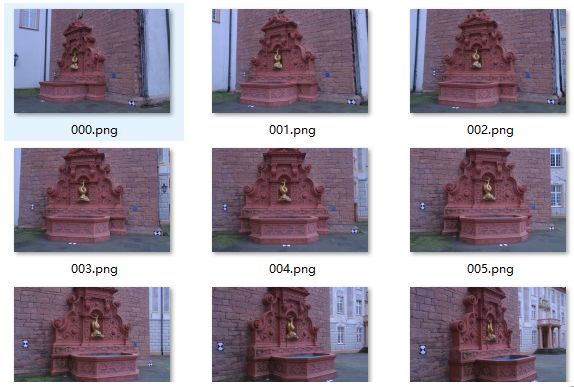SfM多视图三维点云重建--【VS2015+OpenCV3.4+PCL1.8】
难点
在完成两视图三维重建之后,接下来就是进行多视图重建。多视图重建的难点在于如何确定第 i i i( i i i>2)个相机到世界坐标系的位姿变换矩阵。
两视图重建时,是将第一个相机所在的坐标系视为世界坐标系,并计算第二个相机相对于第一个相机的位姿变换矩阵。但这种方法并不能用在多视图重建中,即不能将第 i i i( i i i>2)个视图依次与第一个视图进行特征点匹配,并根据匹配的特征点进行双目重建,因为随着帧数增加,当前帧与第一帧之间可能无法找到足够的匹配特征点;也不能采取1与2、2与3、3与4这样依次两两视图重建的方式,因为如此两视图重建得出的是 i + 1 i+1 i+1帧与第 i i i帧的相对位姿,且丢失了 t t t的尺度信息,无法通过依次连乘转到第1帧代表的世界坐标系下。
可参考:OpenCV实现SfM(三):多目三维重建
解决方法
其实这就是所谓的PnP问题了,“PnP是求解3D到2D点对运动的方法,它描述了在已知n个3D空间点以及它们的投影位置时,如何估计相机所在的位姿”。而Opencv中提供了相关的函数solvePnP及solvePnPRansac可直接使用。已知的3D空间点的坐标是世界坐标系下的坐标,因此使用solvePnP获得的相机位置也是在世界坐标系下位置,即第 i i i个相机到第一个相机的变换矩阵,在此基础上就可以使用三角法进行三维重建了。
本文采用增量SfM方式进行多视图三维重建
代码
环境:Win10+VS2015+OpenCV3.4+PCL1.8
#include 结果
下图是用来重建的6张图片(000.png-005.png):


备注
- 当使用多张图片进行重建时,我发现随着图片数量的增加,重建后的点云在PCL中的显示尺寸也在被逐渐缩小。为了能清晰的观察重建效果,也就需要放大更大的倍数。但是当使用超过6张图片进行重建时,就会达到PCL可放大的最大倍数,也就是说放大到最大也无法观察到重建的点云效果,只会是一团很小的点云。当然这只是显示的问题,重建的结果并没有问题。关于这个问题,我尚未解决,如果大家有解决方案,欢迎不吝赐教。
- 最难理解的是vector
correspond_struct_idx,若correspond_struct_idx[i][j]=N,则代表第i幅图像第j个特征点(即key_points_for_all[i][j])与重建后的空间点points3D[N]对应。若N<0,说明该特征点没有被用于三维重建。这么做的主要原因是使用前两张图片进行重建时,并不是所有的特征点对都被用来重建,而是有一部分被滤除掉了。虽然后面所有的匹配点对都被用来重建,但是因为points3D中前两张图片重建的点对已经造成了偏移,即N != j。 - 完整工程下载:SfM稀疏三维点云重建【VS2015+OpenCV3.4+PLC1.8】–完整工程文件